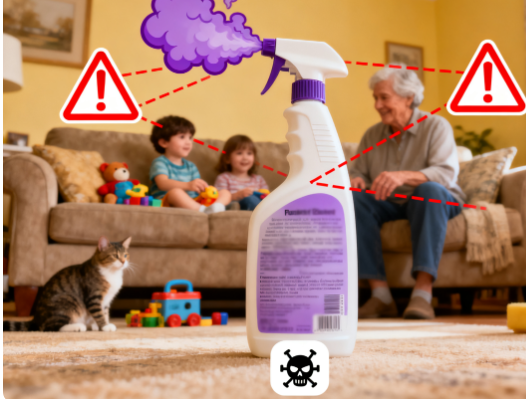
This Household Item Is Poisoning Your Family… See More
Picture this: it’s a quiet Tuesday evening. You’re preparing dinner in your spotless kitchen, wiping the counter with a trusted cleaner that promises to “kill 99.9% of germs.” The fresh, chemical scent fills the air—a smell you’ve always associated with cleanliness and safety. But what if that familiar aroma is actually a warning sign? What if the very product you’re using to protect your family is slowly, silently harming them?
For millions of Americans, particularly those over 50 who take pride in maintaining their homes, this scenario isn’t just hypothetical—it’s a daily reality. The culprit? Conventional cleaning products—especially aerosol sprays and bleach-based cleaners—that release volatile organic compounds (VOCs) and other toxins into the air we breathe.
We’ve been conditioned to believe that a clean home must smell like chemicals. That lemony-fresh or pine-scented odor? It’s often a cocktail of synthetic fragrances and solvents that can trigger or worsen health issues—especially in older adults and grandchildren who frequently visit.
Why Older Adults Are Particularly Vulnerable
As we age, our bodies become less efficient at processing toxins. Lung capacity decreases, liver and kidney function decline, and immune systems weaken. What might cause minor irritation in a 30-year-old can lead to significant health problems in someone over 60. Common cleaning products have been linked to:
- Increased asthma attacks and respiratory irritation
- Hormone disruption (endocrine disruption)
- Skin allergies and dermatitis
- Headaches and migraines
- Even long-term increased cancer risk
The EPA has found that indoor air can be 2-5 times more polluted than outdoor air—largely due to household cleaners. And when you consider that older adults spend up to 90% of their time indoors, the exposure becomes particularly concerning.
The Worst Offenders in Your Home
- Aerosol Sprays
Whether it’s air freshener, furniture polish, or cleaning spray, aerosols create fine particles that are easily inhaled deep into the lungs. Many contain phthalates (hidden under “fragrance” on labels) that disrupt hormones. - Bleach-Based Cleaners
Chlorine bleach releases fumes that can irritate eyes, skin, and respiratory tracts. When mixed with ammonia (found in some glass cleaners), it creates toxic chloramine gas—a danger many unknowingly create while cleaning. - Antibacterial Products
Triclosan and other antibacterials don’t just kill germs—they may contribute to antibiotic-resistant bacteria and disrupt thyroid function. - Oven Cleaners
These are among the most toxic products in any home, containing lye and other caustic chemicals that can cause severe burns and respiratory damage.
Simple Swaps for a Safer Home
The good news is that creating a clean, healthy home doesn’t require dangerous chemicals. Our grandparents knew this—they cleaned with simple, effective ingredients that are still available today:
- White Vinegar
Excellent for cutting grease, removing mineral deposits, and disinfecting surfaces. Mix with water in a spray bottle for an all-purpose cleaner. - Baking Soda
A gentle abrasive perfect for scrubbing sinks, tubs, and ovens. Also neutralizes odors in refrigerators and carpets. - Hydrogen Peroxide
A effective disinfectant that breaks down into harmless water and oxygen. Great for cutting boards and countertops. - Castile Soap
A plant-based soap that works for everything from dishes to floors to hand washing. - Essential Oils
For scent, use real essential oils like lemon, lavender, or tea tree—which have natural antibacterial properties.
Making the Transition
Start with one product at a time. When your current cleaner runs out, replace it with a non-toxic alternative. Look for products labeled “fragrance-free” (not unscented, which often means masking fragrances are used) and avoid anything with warning labels like “Danger” or “Poison.”
Better yet—make your own. Mix vinegar and water in a spray bottle with a few drops of lemon essential oil for a fresh-smelling, effective cleaner that costs pennies per batch.
Your home should be your sanctuary—not a source of hidden toxins. That “clean” chemical smell? It’s not cleanliness—it’s contamination. True cleanliness doesn’t have a smell at all.
So the next time you reach for that familiar spray bottle, ask yourself: am I making my home safer—or just making it smell like I did?